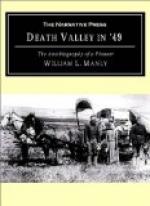The trail bearing still to the north from this point, we left and turned due east across the country, and soon came to a beautiful lake of sweet fresh water situated well up toward the top of the mountain. This lake is now called Elizabeth Lake. Here we watered our animals and filled our canteens, then steered a little south of east among the Cabbage trees, aiming to strike the rain water hole where we had camped as we came over. We reached the water hole about noon and here found the Jayhawkers trail, which we took. They had evidently followed us and passed down the same brushy canon while we having taken a circuitous route to the north, had gone around there. Getting water here for ourselves and horses, we went back to the trail and pushed on as fast as the animals could walk, and as we now knew where we could get water, we kept on till after dark, one of us walking to keep the trail, and some time in the night reached the Willow corral I have spoken of before. There was good water here, but the Jayhawker’s oxen had eaten all the grass that grew in the little moist place around, and our animals were short of feed. One of us agreed to stand guard the fore part of the night and the other later, so that we might not be surprised by Indians and lose our animals. I took the first watch and let the blaze of the fire go out so as not to attract attention and as I sat by the dull coals and hot ashes I fell asleep. Rogers happened to wake and see the situation, and arose and waked me again saying that we must be more careful or the Indians would get our horses. You may be sure I kept awake the rest of my watch.
Next day we passed the water holes at the place where we had so stealthily crawled up to Doty’s camp when coming out. These holes held about two pails of water each, but no stream run away from them. Our horses seemed to want water badly for when they drank they put their head in up to their eyes and drank ravenously.
Thirty miles from here to the next water, Doty had told us, and night overtook us before we could reach it, so a dry camp was made. Our horses began now to walk with drooping heads and slow, tired steps, so we divided the load among them all and walked ourselves. The water, when reached proved so salt the horses would not drink it, and as Doty had told us the most water was over the mountain ahead of us, we still followed their trail which went up a very rocky canon in which it was hard work for the horses to travel. The horses were all very gentle now and needed some urging to make them go. Roger’s fat horse no longer tried to unseat its rider or its pack, but seemed to be the most downhearted of the train. The little mule was the liveliest, sharpest witted animal of the whole. She had probably traveled on the desert before and knew better how to get along. She had learned to crop every spear of grass she came to, and every bit of sage brush that offered a green leaf was given a nip. She would sometimes leave the trail and go out to one side to get a little bunch of dry grass, and come back and take her place again as if she knew her duty. The other animals never tried to do this. The mule was evidently better versed in the art of getting a living than the horses.




